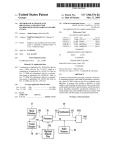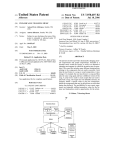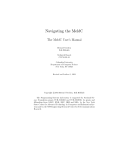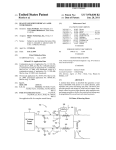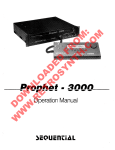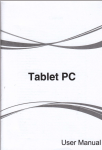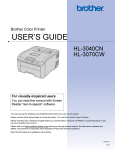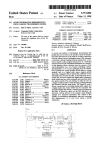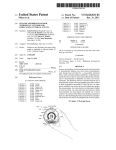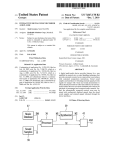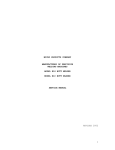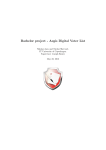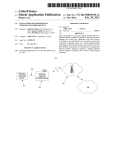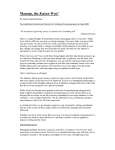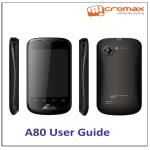Download Interactive digital music recorder and player
Transcript
USOO8704073B2 (12) United States Patent (10) Patent N0.2 Georges (54) US 8,704,073 B2 (45) Date of Patent: INTERACTIVE DIGITAL MUSIC RECORDER (52) AND PLAYER *Apr. 22, 2014 us. C1. USPC ................. .. 84/645; 84/603; 84/622; 84/659; 84/477 R (75) Inventor: Alain Georges, Flayosc (FR) (58) Field of Classi?cation Search None See application ?le for complete search history. (73) Assignee: Medialab Solutions, Inc., Marshall, TX (Us) (*) Notice: (56) Subject to any disclaimer, the term of this patent is extended or adjusted under 35 U.S. PATENT DOCUMENTS U.S.C. 154(b) by 0 days. This patent is subject to a terminal dis claimer. 8/1983 Aoki ............................ .. 84/l.03 3/1986 Levy et al. ............. .. 379/101.01 FOREIGN PATENT DOCUMENTS EP EP Dec. 3, 2010 (65) 4,399,731 A 4,577,067 A (Continued) (21) Appl.No.: 12/928,161 (22) Filed: References Cited 484047 0702366 (Continued) Prior Publication Data US 2011/0197741 A1 10/1991 9/1995 OTHER PUBLICATIONS Aug. 18, 2011 Beatnik Rich Music Format, 2 pages, 2002. Related US. Application Data (63) (Continued) Continuation of application No. 12/322,862, ?led on Feb. 8, 2009, now Pat. No. 7,847,178, which is a continuation of application No. 11/705,555, ?led on Feb. 10, 2007, now Pat. No. 7,504,576, which is a continuation of application No. 10/634,346, ?led on Aug. 4, 2003, now Pat. No. 7,176,372, which is a continuation of application No. 09/691,314, ?led on Oct. 17, 2000, now abandoned, which is a continuation-in-part of application No. 09/690,911, ?led on Oct. 17, 2000, now abandoned, and a Primary Examiner * Marlon Fletcher (74) Attorney, Agent, or Firm * Loudermilk & Associates (57) ABSTRACT A digital multi-media device provides features for a user unskilled in musical arts or sound handling techniques that provides automatic musical score composition in accordance with contained composition instructions. Stored sound samples and interfaces for obtaining external signals provide continuation-in-part of application No. 09/691,302, signals for merger with visual and sound presentations to ?led on Oct. 17, 2000, now Pat. No. 6,392,133. obtain altered presentations either time shifted or in real time. In this fashion the user can create simulated radio stations for (30) Foreign Application Priority Data Oct. 19, 1999 Nov. 17, 1999 (FR) .................................... .. 99 13036 (FR) .................................... .. 99 14420 playback of prearranged and composed audio material. Fur ther, the automatically composed musical score may be mixed with synthesized, digitized signals from the stored sound samples and external signals obtained through the device interfaces. (51) Int. Cl. G10H 7/00 13 Claims, 8 Drawing Sheets (2006.01) 18 17 US 8,704,073 B2 Page 2 (56) References Cited 6,506,969 B1 6,541,691 6,576,828 6,576,878 6,639,141 US PATENT DOCUMENTS 4,787,073 A 11/1988 Masaki ......................... .. 369/32 5,054,360 A 10/1991 Lisle etal‘ n 5,099,740 A 5,177,618 A 5267318 A 5,281,754 A 3/1992 1/1993 B2 B2 B2 B2 1/2003 Baron ........................... .. 84/609 4/2003 6/2003 6/2003 10/2003 Tolonen et a1. . .. 84/616 Aoki et a1. .... .. .. 84/635 Thorpe et a1. ............... .. 219/645 Kay ~~~~~~~~~~~~~~~~~~~~~~~~~~~~~~ ~~ 84/609 84/645 6,645,067 B1 11/2003 Okltaetal. .. Minamitaka ,,,,,,,,,,,,,,,,,, H 34/649 Dunlap etal. .............. .. 358/335 6,657,116 B1 6,683,241 B2 12/2003 1/2004 6,696,631 B2 6,815,600 B2 2/2004 Smlth etal. 11/2004 Georges et a1. . 11/1993 Severson 1/1994 Farrett et al‘ 5,300,723 A 4/1994 Ito “““““ n 5,307,456 A 4/1994 381/51 84/609 MacKay ,, GunnefSOIl ~~ Wléder ~~~~~~ ~~ 463/7 ~~ 84/615 ~~ 84/609 .. 84/645 .. 84/609 84/601 6,835,884 B2 12/2004 Iwamoto et a1. .. 84/609 , 395/154 6,835,387 B2 12/2004 Devecka ~~~~~~~ ~~ ~~ 34/743 5308915 A 57994 Ohya 395/22 6,897,368 B2 5/2005 Georges et al. ............... .. 84/609 5,350,880 A 9/1994 Sam “““““““ H 84/609 6,916,978 B2 7/2005 11/1994 Yamashita etal . 84/611 6,970,822 B2 5,369,217 A 5,386,081 A 1/1995 Nakadaetal ,,,,,,,,,,,,,,,, ,, 84/609 7,078,609 132* Georges et al. ............... .. 84/609 11/2005 Fay etal~ 704/270 7/2006 Georges ~~~~~ ~~ ~~ 84/645 Georges et al~ ~ ~~ 84/609 5,425,297 A 6/1995 Youngjr ,,,,,,,,,,,,,,,,,, H 34/4831 7,169,996 132* 1/2007 5,451,709 A 9/1995 Minamitaka 84/609 7,173,178 B2* 2/2007 Kobayashi .. 84/645 5,496,962 A 3/1996 Meier et a1. . 84/601 7,176,372 132* 2/2007 Georges ~~ 84/609 7,183,482 B2 7,189,915 B2 7,223,190 132* 2/2007 Kobayashi 3/2007 Kobayashi 6/2007 Dowllng étal~ .. 84/645 ~~ 84/645 7/2007 KQbaYaShl ~~ 700/94 ~~ 84/609 V2008 Wleder ~~ 84/609 5523525 A 5,581,530 A 5,590,282 A 6/1996 Mmakm et al 12/1996 Ilzuka etal 12/1996 Clynes ,,,,,,,,, ,, 84/602 369/93 95/200,02 5,627,335 A 5/1997 Rigopulosetal .... .. 84/635 7,241,947 B2 395/2.76 7,319,185 B1 5,633,985 A 5/1997 5,640,590 A 6/1997 Luther Severson ..... .. 5,648,628 A 5,650,583 A 7/1997 Ng etal‘ 7/1997 Machoveretal ‘ 395/806 7,465,867 B2* 84/610 84/626 7,504,576 B2* 7,705,232 132* 5,655,144 A 5,675,557 A 8/1997 Milne et a1. . 395/807 10/1997 Hubinger ““““““““““““ n 369/4 7,847,178 132* 2002/0038157 A1* 5,689,081 A 11/1997 5,753,843 A Tsurumi ““““““““““““ H 84/609 5/1998 Fa “““““““ n 5,763,804 A 6/1998 Rigopulos etal 5,787,399 A 7/1998 Lee “““““““ n 12/2008 Glatt 3/2009 Georges 4/2010 Glatt 12/2010 3/2002 Georges ~~~~~ ~~ D0Wl1ngeta1. 2004/0069121 A1* 4/2004 Georges ..... .. .. 84/609 2004/0074377 A1* 4/2004 Georges .. 84/609 84/635 2004/0094020 A1* 5/2004 Wang et al. .. 84/622 ‘ 704/270 2007/0079692 A1* 4/2007 .. 84/645 2007/0186752 A1* 2007/0209498 A1* 2007/0227338 A1* 8/1998 Timis et al‘ ‘ 9/1998 Gershen 10/1998 Gabriel 84/609 ‘ 345/339 84/609 538323431 A 11/1998 Severson , 704/258 2008/0156178 A1* 5,839,108 A 5,850,051 A 5,864,868 A 11/1998 12/1998 1/1999 Daberko et a1. ............ .. 704/270 Machoveretal, ,,,,,,,,,,,, ,, 84/634 Contois ““““ n ‘ 707/104 2009/0064852 A1* 2009/0241760 A1* 2010/0031804 A1* Glatt .......... .. 8/2007 Georges et a1. . .. 84/609 9/2007 Lindgren et a1. .............. .. 84/609 10/2007 Georges ........................ .. 84/602 7/2008 Georges et a1. . 3/2009 10/2009 2/2010 619“ ~~~~~~~~~~ ~~ Georges ~~~~~ ~~ Chevreau et a1. 5,877,445 A 3/1999 Huffordetal‘ 84/602 2010/0260363 A1* 10/2010 Glatt etal. 5,886,274 A 5900566 A 3/1999 Jungleib 5/1999 Mino 84/601 84/610 2011/0197741 A1* 2012/0024131 A1* 5,913,258 A 6/1999 Tamura 5,914,941 A 6/1999 Janky ..... .. . 370/313 5,928,330 A 5,969,716 A 7/1999 GoetZ et al 10/1999 Davis etal. . . 709/231 . 345/328 5,981,860 A 11/1999 Isozaki ............ .. 84/603 EP EP 6,008,446 6,011,212 6,051,770 6,072,480 6,074,215 6,083,009 12/1999 Van Buskirk et a1. 1/2000 Rigopulos etal. . 4/2000 Milburn et a1. 84/603 84/667 84/611 GB JP W0 6/2000 Gorbet et a1. 6/2000 Tsurumi 7/2000 Kim et a1. . 345/302 . 434/307 . 434/307 7/2000 Sitrick 7/2000 Arnalds 84/477 84/464R A A A 6,084,168 A 6,093,880 A 6,121,533 A 9/2000 Kay ....... .. FOREIGN PATENT DOCUMENTS 0747377 0857343 6/1996 10/1996 4/1997 1/2000 7/1983 W0 WO W0 2306043 06295567 W0 gig/05200 WO 39/02641 WO 97/15043 WO 97/35299 W0 WO WO 93/33169 WO 01/63592 7/1993 55/2001 3/1989 4/1997 9/1997 84/616 W0 WO 01/73743 10/2001 84/609 84/645 W0 WO W0 01/556630 WO0136625 11/2001 11/2001 6,153,821 A 6,182,126 B1 11/2000 Fay et a1. ...................... .. 84/634 1/2001 Nathan et a1. ............... .. 709/219 2/2001 Abecassis . 704/270 WO WO WO WO0136626 WO0136627 WO0136623 11/2001 11/2001 11/2001 6,225,547 B1 5/2001 Toyama et al. 84/611 WO WO0186629 11/2001 6,230,140 B1 6,245,984 B1 5/2001 Severson 6/2001 Aoki et a1. .. . 704/278 84/611 W0 W0 02/077535 10/2002 8/2001 6,326,538 B1 12/2001 6,343,055 B1 1/2002 Koike et a1. . . 84/636 Kay ....... .. Emaetal. 381/312 84/604 11/2000 Aoki et a1. 11/2000 Kikuchi 6,281,424 B1 .. 84/645 ~~ 84/645 ~ 84/645 .. 84/609 8/2011 Georges ..... .. .. 84/645 2/2012 Georges et a1. ............... .. 84/645 6,143,971 A 6,143,973 A 6,192,340 B1 ~~ 84/645 .. 700/90 84/609 5,792,971 A 5,801,694 A 5 824 933 A A A A .. 84/645 .. 84/645 ~~ 84/645 84/635 .... .. 369/5316 OTHER PUBLICATIONS _ _ _ _ 6,347,998 B1 6,353,169 B1 6,353,172 B1 2/2002 Yoshitomietal. ............ .. 463/42 3/2002 Juszkiewicz et a1. ......... .. 84/600 3/2002 Fay et_ al~ ~~~~~~~~~ ~~ 84/609 253835;? 3% ggggg 6,425,018 B1 7/2002 Kaganas et al‘ ““““““““ H 710/1 Combiningmusical theory andpractice, IBM Computer Music Cen tenal>l>an°ll?y Jun 29, 1995 '31, """"" ‘11: 22/36/22 6,425,822 B1 7/2002 Hayashida et a1. 6,429,863 B1 6,450,888 B1 6,472,591 B2 8/2002 LOPiCCOlO et al‘ , 9/2002 Takase etal. .. 10/2002 Aoki et al. .. 463/7 6,482,087 B1 11/2002 Egozy et a1. .................... .. 463/7 , 345/419 463/43 84/611 Beatnlk Audlo Englne Whlte Paper, 61298982001 BeatnikAudioEngine, 2pages, 2002. Beatnik mobileBAE version 02.02W, 2pages, 2002. Beatnik mobileBAE version 11~02w, 2P3g65,2002~ dream, anAtmel Company: SAM9407, “Programmer’s Reference,” p11 1-61,Rev, 11,Dec, 1996, dream, an Atmel Company: SAM9707, “Integrated Sound Studio,” pp. 1-20, Jan. 1998. US 8,704,073 B2 Page 3 (56) References Cited OTHER PUBLICATIONS USPTO Publication No. US 2002/0033090, Iwamoto et al., Pub lished Mar. 21, 2002. USPTO Publication No. US 2002/0046315, Miller et al., Published GenJam: An Interactive Genetic Algorithm Jazz Improviser, John A. USPTO Publication No. US 2002/ 0046899, Mizuno et al., Published Apr. 2002. Biles, popular version of paper 4pMU1 apparently presented Dec. 4, 1997. GenJam: A Genetic Algorithm for Generating Jazz Solos, John A. Biles, date apparently after 1993. Apr. 25, 2002. USPTO Publication No. US 2002/0065074, Cohn et al., Published May 2002. GenJam Populi: Training an IGA via Audience-Mediated Perfor USPTO Publication No. US 2002/ 0166440, Herberger. USPTO Publication No. US 2002/0170415, Nov. 21, 2002, “System and Method for Music Creation and Rearrangment”, by Hruska et al., mance, John A. Biles, apparently Sep. 15, 1995. US. Appl. No. 10/106,743. Information on how to purchase Kid Riffs, IBM, date unknown. Interactive GenJam: Integrating Real-Time Performance with a USPTO Publication No. US 2002/0175665, O’Grady et a1. USPTO Publication No. US 2003/0013497, Yamaki et al., Published Jan. 16, 2003. USPTO Publication No. US 2003/0079598, Nakayama, Published Genetic Algorithm, John A. Biles, apparently after 1996. Hemmings, Richard, Scary Computer Music, apparently from Avant Magazine, Issue 7, Summer 1998, p. 12. Kid Riffs, IBM Computer Music Center, date unknown. Louis, Duke, Milesiand MAC? Business Week Archives, appar ently Dec. 18, 1995. Mithic, a New Generation of Music, Thomson Multimedia, 3 pages, Jul. 8, 2002. Mithic, the First Interactive Music Composer, 2 pages, 2002. Thomson Multimedia presents Mithic Technology, 3 pages (2 slides per page), undated. Thomson Multimedia launches Mithic, a unique Technology to to deliver personalized interactive Music, Feb. 25, 2002. Thomson to present the Mithic Composer Technology at DEMOmobile Conference, Sep. 19, 2002. Mobile Media Analyst, “Music Services Might Soon Break Out of the Ring-Tone Mold,” Mobile Media management report, pp. 5-12, Jan. 10, 2003. Motorola C350 Cellular Phone User Manual, selected pages on MotoMixer Sound Editor, Motorola, Inc., pp. 1, 2, 129-131, 2002. Music Sketcher, IBM Computer Music Center, date unknown. Music Sketcher Section Details, IBM, apparently 1998. Musical Computers, Miles Davis, version 2.1, apparently from the Economist, Dec. 6, 1997, p. 92. Roland Corporation, “Personal Music Assistant Owner’s Manual”, Dec. 18, 1995, Entire Manual. Yamaha Mobile Audio 3, MA-3, YMU762, Yamaha LSI, Yamaha Corp., Preliminary May 9, 2001, p. 1-14. May 2003. USPTO Publication No. US 2003/0176206, Taniguchi et al., Pub lished Sep. 18, 2003. USPTO Publication No. US 2003/ 0183065, Leach. USPTO Publication No. US 2003/0205125, Futamase et al.., Pub lished Nov. 6, 2003. USPTO Publication No. US 2004/0039796, Watkins, Published Feb. 2004. USPTO Publication No. US 2004/0064320, Chrysanthakopoulos et al., Published Apr. 1, 2004. USPTO Publication No. US 2004/0088169, Smith et al., Published May 6, 2004. USPTO Publication No. US 2004/0106395, Suganuma. USPTO Publication No. US 2004/ 0109558, Koch. USPTO Publication No. US 2004/0231499, Kobayashi, Published Nov. 2004. USPTO Publication No. US 2005/ 0190199, Brown et al. USPTO Publication No. US 2006/0156909, Kobayashi, Published Jul. 2006. USPTO Publication No. US 2006/0185504, Kobayashi, Published Aug. 2006. Excerpts from File History of related U.S. Appl. No. 10/634,622. Excerpts from File History of related U.S. Appl. No. 11/705,555. Excerpts from File History of US. Appl. No. 10/324,389. Chong (John) Yu, “Computer Generated Music Composition,” May 28, 1996, 21 pages (MIT Thesis). Tom Hays, “DirectMusic for the Masses”, Gamasutra.com article Mary Farbood, “Hyperscore: A New Approach to Interactive, Com believed to be originally published in Game Developer Magazine Sep. 1998, 27 pages. Microsoft, “Microsoft DirectMusic Producer: Game Development puter-Generated Music,” Sep. 1, 2001, 78 pages (MIT Thesis). Tutorial”, believed to be dated Nov. 12, 2002 (?le date of electronic ?le) or earlier, 52 pages. USPTO Publication No. US 2001/0025561, Milburn et al., Published tion and Performance,” Aug. 5, 1994 (MIT Thesis). Oct. 2001. Thesis). USPTO Publication No. US 2002/0023529, Kurakake et al., Pub lished Feb. 28, 2002. * cited by examiner Alexander Rigopulos, “Growing Music from Seeds: Parametric Gen eration and Control of Seed-Based Music for Interactive Composi Eran Baruch Egozy, “Deriving Musical Control Features from a Real-Time-Timbre-Analysis of the Clarinet,” Jan. 20, 1995 (MIT US. Patent Apr. 22, 2014 Sheet 1 0f8 US 8,704,073 B2 18 17 \11 US. Patent Apr. 22, 2014 2:HQ'F Sheet 2 of8 US 8,704,073 B2 2Music.92 ADPCM & Compressron Parametric Sound F X DcCOder 2Musical91 Algorithms f1 Synthesizer l /CODEC USB PC /I Interface 28 Digita Structure Multi-media with MIDI Platform 31 J Ilgeragiwe raP 1“ Interface 291 3 26 . \ Keyboard LCD / \ Interface TV/Video Flash FM Intgffacg Memory Receiver 33 V01ts Tuner 27 19 23 33 32 FIG. 2 Digital US. Patent 397 Music Database Apr. 22, 2014 DM Sheet 3 0f8 36 Ml 8 39 US 8,704,073 B2 . V Synthesrzer M2 2 41 9 , ‘ Processor MA3 32 ——0 Sound Samples 31 38 FIG. 3 39 386 Processor 42€A M1~ Synthesizer M2 ' DAC MA2 52 ‘ DAC 42B FIG. 4 SA2 44 $1.4“ US. Patent 386 Apr. 22, 2014 Sheet 4 0f8 3 8 9 M1, Synthesizer M2 Processor 82 US 8,704,073 B2 487 ' MA3 DAC —0 FIG. 5 3: Processor ‘ M1 3 9 ' Synthesizer M2 M3 FIG. 6 497 MA3 DAC —0 US. Patent Apr. 22, 2014 Sheet 5 of8 36 US 8,704,073 B2 39 e M e , Processor 47 e _ 32 M3 Synthesrzer MA3 ‘ DAC Instrumental Sounds - J0 n/ 48 Sound Samples 36 INST 9 W K39 Processor 49 47 $2 51 SW FIG. 9 SIAZ ‘ - ' Synthesrzer 9 M3 ‘ MA3 ' DAC —0 52 36 38 g g 9 DAC 812 ~ Processor SB ~ Memory US. Patent Apr. 22, 2014 US 8,704,073 B2 Sheet 6 0f 8 2 2~ 8&5 $ M 3 wm G mm @ 82>ow?-em 235a2%m:5&5\@2038%;2>8562 Ecme 82> ~32 2a~<2280 62 $9 7 $2$5c28m0 528 38 E@ 28 $ 25cm 89: 2GE US. Patent Apr. 22, 2014 Sheet 7 of8 US 8,704,073 B2 Muswal Q Flles - Processor 4/36 Memory /' W43 Al A2 K37 K39 Music Database _ S3 Syntheslzer ‘ 53 L g i 2 A3 _§)2 43A Sound 38/1/ Samples Mammy 397 Music Database DM 36 FIG. 11 M1 9 39 . ' Synthesmer ‘ M66 Samples e S2 k r ‘ 31 e 38 433 , Processor Sound M2 FM Digitized 43” R d. a 10 Receiver @64 Musical Files FIG. 12 MA3 __0 US. Patent Apr. 22, 2014 Sheet 8 0f 8 US 8,704,073 B2 70 Process MIDI Information; Provide to Processing Resource Process Sound Sample; Provide Audio Sample Data to Processing Resource @ Synchronize Playback of Audio Sample Data and MIDI Information based on Musical Bar Timing FIG. 13 71 US 8,704,073 B2 1 2 INTERACTIVE DIGITAL MUSIC RECORDER AND PLAYER player a module that generates music or other sounds which either can be mixed with the originally recorded sound (sound mixing), or can replace the originally recorded sound (sound dubbing). This sound mixing or dubbing can be performed This application is a continuation of US. application Ser. No. 12/322,862 ?led Feb. 8, 2009, now US. Pat. No. 7,847, 178, which is a continuation of US. application Ser. No. 11/705,555 ?led Feb. 9, 2007, now US. Pat. No. 7,504,576, which is a continuation of US. application Ser. No. 10/634, 346 ?ledAug. 4, 2003, now US. Pat. No. 7,176,372, whichis a continuation of US. application Ser. No. 09/691,314, which is a continuation-in-part of US. application Ser. No. 09/ 690, 911 ?led Oct. 17, 2000 (which claims priority on French Patent Reg. No. 99 13036, ?led Oct. 19, 1999) and Ser. No. 09/691,302 ?led Oct. 17, 2000 (which claims priority on either at video/audio record time or at play time. Additionally the invention envisions selection of musical pieces either out of a library stored for instance in the form of digitized musical ?les, MIDI ?les or other types of ?les, or from pieces that are composed in a pseudo-random fashion using, for example, a synthesizer function to play original musical pieces. The invention further envisions selection of musical pieces according to a speci?ed musical style, in a pseudo-random fashion, or according to prede?ned criteria, wherein the audio French Patent Reg. No. 99 14420, ?led Nov. 17, 1999). ?les meet the prede?ned criteria and are either extracted from a music library or are generated by an automatic composition BACKGROUND OF THE INVENTION (a) Field of the Invention The current invention relates to a device that provides for interaction with a user during recording, playing, composing and modifying musical selections. (b) Description of Related Art Various devices capable of composing a musical piece automatically have been developed, such as that described in 20 station by the use of one or several of the aforementioned functions. Further, the invention permits selection of musical pieces, by a user, either from a library in which musical pieces 25 a radio receiver, or from pieces that are composed in a pseudo random fashion using a synthesizer function to play original musical pieces. face) standard, “scores” of notes that are composed automati 30 Thus, the present invention provides for selection accord ing to a pre-selected musical style, in a pseudo-random fash ion or according to a pre-de?ned criteria, of audio ?les to be played from a speaker, wherein the audio ?les meet the pre 35 generated by an automatic composition function. Further, the can possess one or several audio inputs, which permit mixing or replacement of the sound track that was recorded originally during the recording of the image with an external audio are stored as compressed musical ?les, MIDI ?les or other similar types of ?les, from pieces recorded from the output of US. Pat. No. 4,399,731. These devices are based on synthe sizers of instrumental sounds on which are applied, for instance as per the MIDI (Musical Instrument Digital Inter cally. Various devices capable of recording or playing video recordings have already been developed, such as digital or analog camcorders and other video recorders. These devices function. The resulting sounds are used either during the video recording or during the video playback. The present invention represents an improvement of the aforementioned devices by simulating the reception of a radio de?ned criteria and are either extracted from the library or recording of or the automatic generation of sentences that source. Furthermore, there also exist various devices that are mimic the speech of a “disc-jockey” or of an announcer capable of playing recorded pieces, such as digital compact disc players, players of compressed ?les (for instance as per permits combination of speech passages with the musical pieces being played, thereby giving the user the illusion that the MPEG-level 3 standard), etc. Finally, there exist devices incorporating a tuner, which permit reception of radio broad 40 BRIEF DESCRIPTION OF THE DRAWINGS casts via electromagnetic waves. SUMMARY OF THE INVENTION 45 An interactive digital multi-media device provides a user with multiple related features, wherein it is not necessary that 50 FIG. 3 is a block diagram of the automatic composer of the FIG. 4 is a block diagram showing one structure for sum 55 FIG. 5 is a block diagram showing another structure for FIG. 6 is a block diagram showing a ?rst variant of the diagram of FIG. 3. 60 FIG. 7 is a block diagram showing a second variant of the diagram of FIG. 3. samples are mixed with a melody in the process of the auto The invention herein further represents an improvement over prior art devices by integrating in a video recorder or ming outputs in the present invention. summing outputs in the present invention. previously recorded sound samples wherein the sound matic composition. The sound samples will typically, but not exclusively, be human voice samples. the present invention. FIG. 2 is a functional block diagram of the present inven tion. present invention. matic musical composition instructions are stored so that the user is able to create unique musical compositions. Compo nents are provided that function to mix externally obtained sound with the unique musical compositions and stored audio and voice samples to provide altered audio and voice presen tations. The present invention includes an improved automatic composition device that adds to instrumental sounds some The above objects and other advantages of the present invention will become more apparent by describing in detail the preferred embodiments of the present invention with ref erence to the attached drawings in which: FIG. 1 is a perspective of the digital multi-media device of the user have training in musical or sound handling arts. A programmable memory is used to store digital audio and voice samples. External sound recovers provide external sound signals, such as radio and TV signals that may also be stored. Playback means is provided connected to the stored audio and voice samples and the external sound signals.Auto he is listening to an actual radio station. 65 FIG. 8 is a block diagram of another embodiment of the automatic composer of the present invention. FIG. 9 is a block diagram of a variation of the present invention. FIG. 10 is a block diagram of another aspect of the present invention. US 8,704,073 B2 4 3 (WMA), illustrated at 22 in FIG. 2, having ?les in the active FIG. 11 is a block diagram of an additional aspect of the present invention. streaming format (ASF). WMA provides a higher compres sion ratio for equivalent sound quality as compared to previ ous compression techniques, i.e., MP3. DMA compression techniques allow a compression ratio approximately twice FIG. 12 is a block diagram of yet another aspect of the present invention. FIG. 13 is a ?ow chart illustrating one preferred embodi ment of the present invention. that of MP3, thereby allowing for over two hours of music to be stored on a 64 megabyte SmartMedia card. The WMA DETAILED DESCRIPTION OF THE PREFERRED EMBODIMENTS playback function supports the Digital Rights Management (DRM) technology that is used with audio ?les. This technol ogy can be used to encrypt the compressed data, which can The present invention will be described in greater detail with reference to certain preferred and alternative embodi ments. As described below, re?nements and substitutions of the various embodiments are possible based on the principles then only be decoded correctly with a private key. As a result, a user can download music from the Internet that is protected with the DRM technology and receive rights to play music on a particular DMM that has been previously registered. ASP and teachings herein. and MIDI ?les can be copied on the SmartMedia card either via a serial PC connection offered by the DMM device or directly with an off the shelf SmartMedia card reader. Internal The invention disclosed herein is an interactive digital music player that allows one or more users to listen to, com pose, and interact with music in any environment. The device is a hand-held digital music player that offers numerous unique features that, until now, have not existed in a single (e-DJ) automatically composes and plays in real-time music memory and SmartMedia memory 19 further provides the ability for the DMM to obtain ?rmware and sound upgrades from the Internet. An electronic DJ and virtual radio functions are provided in a multitude of genres (such as a dance or techno), which can by a group of musical algorithms 21 that allow a user to 20 music product. One of the many features, the Electronic DJ be mixed with user-supplied voice samples. The e-DJ offers a unique interactive way of playing with music. At any moment, the user can take the control of the music played by the e-DJ via an attractive interface (joystick, graphical dis play). The user can change the music patterns played by various instruments, change the relative level, apply effects, play pre-recorded samples, etc. 25 algorithms. The device also operates as a musical composer assistant. An FM receiver 23 is provided in the DMM so that a user is able to tune to a favorite radio station or to a virtual 30 Further, the disclosed device allows the user to listen to, musical algorithms 21 and to add the users own touches. The an FM radio receiver. Users can listen to both compressed audio and MIDI karaoke music ?les, store music on a plug-in user may interact with the music being played by way of 35 changing the tempo and pitch. Consequently, interaction is available in as much as the user is able to play voice, music or sound samples that can be recorded with a built in micro phone or obtained from the FM radio receiver or any other source. The samples are obtained through the use of a high storing more than 1000 MIDI karaoke-?le songs on a 64 MB smart media memory card and it can provide over 120 min utes of digital music play time. In addition, the disclosed device is able to create music ?les, accept music ?les created by the user, download music from the Internet via a PC, take a music transferred from a PC, or, accept music added from radio station. While music is playing a user is able to take control over automatic composition being undertaken by the create, download, store, and interact with music, and includes SmartMedia memory card (SSFDC storage device), and carry the unit to any location for playing. The device is capable of automatically create and play many different types of music such as dance, techno, rap, easy listening, etc. Unlimited hours of random music may be generated by the musical 40 quality audio compression circuit 24 and are stored in the SmartMedia memory section 19. The controls 13 on the face of the DMM (FIG. 1) provide for introducing the sound any other smart media memory card. When connected to a effects such as wobbler, dobbler, etc. and can be applied at a docking station, the device offers additional features like user’s will during playback of the recorded samples. Addi insertion of Karaoke lyrics in a video source for display on a TV screen, MIDI PC connection or remote control. 45 tionally the controls allow the user to take even more control over the musical content by selecting relative volume of an FIG. 1 shows the device 10 and its docking station 11. A instrument or a group of instruments in a fashion normally number of cables 12 are shown for connection to a number of only possible through the use of a mixing table. The sound of a particular instrument may be altered using ?lters and also ports (not shown) situated at the rear of the docking station 11. The device 10 as shown has a group of controls 13, including buttons, knobs, jacks, etc. and a display 14 on its front surface. 50 edited later. Controls 13 are intuitive using traditional player keys while the graphical display of 14 provides visual feed A connector within a slot 16 is shown on the device that is con?gured to mate with a connector (not shown) on a rear surface of a base 17 on the docking station 11. The docking station includes an inclined surface 18 that supports the device in the docking station when connection is made between the connector in slot 16 and the connector in the may be saved to be later played over again and even to be back in real time of the action the user is undertaking with the musical content. As a result users with no special musical 55 education or skill are able to alter and compose music to their own designs. Audio compression circuit 24 preferably is a circuit based docking station. on a speech compression algorithm using, for example, adap The device 10 is shown in the block diagram of FIG. 2 and will be referred to as a Digital Multi Media Platform (DMM) hereinafter. A large number of features are included in the DMM, one of which is the ability to playback digital audio data from a SmartMedia memory card 19. The digital audio tive differential pulse coded modulation (ADPCM) that can be applied to a useful portion of the recording. As is known in the art, techniques such as PCM and ADPCM provide meth ods of compression of analog data that has been sampled and 60 digitized, typically in which the samples have been digitized, source is either compressed or MIDI. The DMM offers a user the capability to interact with a song being played by chang ing pitch and tempo. The audio compression techniques sup ported in the DMM is Microsoft Windows Media Audio 65 and difference between samples are stored/ sent (rather than the samples themselves), or with adaptive techniques a pre dicted sample/sample difference is computed, and what is stored/transmitted is the difference between the predicted US 8,704,073 B2 5 6 value and the actual value, etc. Such compression techniques composition device of the present invention utilizes a combi are known in the art and used, for example, in various tele nation of notes rather than sounds. Notes, being represented digitally, require less memory for storage than sounds that are usually represented in analog form and take large amounts of phony-type systems. A built in microphone (not shown) in the DMM is used for memory, comparatively, when digitized. Karaoke and DJ functions. Further, it is used with a music synthesizer 26 to provide for audio mixing and other audio sound effects. The synthesizer 26 provides a MIDI interface Further, digital notes are easily altered while digital sounds are not readily changed. As a result, the instant invention may use a microprocessor operating at about 25 MHz and needs whereby, due to the small size of a MIDI ?le, a large number of songs may be made to ?t in the ?ash memory 19 containing the SmartMedia cards. The SmartMedia Flash memory pro only about two (2) megabytes of storage, although, of course, the particular clock speed and storage size are exemplary vides for storage of compressed digital/audio MIDI/Karaoke ?les and voice samples. This is currently the most compact embodiments and the invention is not limited thereto. This may be seen to be much less processor speed and memory Flash Memory form available. The digital nature of the MIDI ?les allows tempo and pitch of music to be dynamically than used in the least capable desktop computer, for example. According to the functional diagram of FIG. 3, one typical adapted to the users requirements. Moreover, when a singer’ s voice is taken from the built in microphone within the DMM and mixed with synthesized or stored sound samples, lyrics embodiment of the automatic composition device of the present invention includes essentially a processor 36, a memory 37 containing a music database for use in the auto may be displayed on a TV/video interface 27 or on the display 14 of FIG. 1 . An external microphone may be plugged into the matic composition device, a memory 38 for storing sound DMM for even more ?exible usage. 20 When the DMM is connected to the docking station 11 and playing MIDI or Karaoke songs, a digital light show is avail able through the TV/video interface 27. The resulting colorful conversion circuit 41 interconnected as shown. Processor 36 is able to compose automatically a melody out of the database patterns have movements and shapes following the beat of speci?c instruments or serve as a compliment to lyrics dis played on the screen 14 or just as a visual assist to the elec tronic DJ music. A universal serial connection 28 to a personal computer allows transfer of audio ?les to and from the SmartMedia/ ?ash memory 19. Additionally the serial connection is avail able to perform a ?rmware upgrade. The MIDI interface 26 in the DMM 10 converts to a synthesizer when connected to a MIDI sequencer through the USB PC interface 28. Firmware for the DMM is stored in the Flash Memory and can therefore be upgraded readily by a user by downloading through the 25 stored in memory 37 using an automatic composition algo rithm containing composition instructions. The automatic composition algorithm also utilizes the sound samples stored in memory 38, in such a way that processor 1 delivers in synchronism on its output a control signal M1 connected to 30 synthesizer 39 and a sound sample signal S2. An output signal M2 of the synthesizer and sound sample signal S2 are then summed and converted to analog form in circuit 41 to deliver the complete audio signal MA3. This audio signal MA3, which forms the output of the invention, can then be presented 35 MIDI PC interface 28. A digital instrument tuner for all modern and classical instruments is shown in FIG. 2 at 32. The compact design obtained in the DMM to afford the portable nature of the device is obtained by housing some functions required only when using the product in a nonmo bile environment to be placed in the docking station 11 of FIG. 1. These functions include the circuitry required for the samples utilized by the automatic composition device, a music synthesizer 39, and a summation and digital to analog in audio form by a stereo sound system. In a preferred embodiment of the invention, the processor is made of a microprocessor or microcontroller having a synchronizing clock and being linked to one or several memories. Clock speed and memory capacity may be rela tively low, 25 MHz and 2 MB being ample in the preferred 40 embodiments. A RAM memory (volatile memory) can serve as the working memory of the microprocessor and can be used to store the sound samples in memory 38, whereas a ROM or EPROM memory can store the microprocessor pro insertion of Karaoke lyrics in a video source and for display gram and the music database in memory 37 used by the on a TV screen as well as an external microphone connection automatic composition device. However, a greater ?exibility will be granted by non-volatile memories: RAM memory for Karaoke recording. A MIDI in/out interface is provided in the docking station 11 for connection to a personal computer or to another MIDI device. A power jack and charge control (not shown) is provided at the rear of the docking station to provide the DMM with a 3 .3 volt power supply in a preferred 45 embodiment as shown at 33 in FIG. 2. The DMM is con?g ured to include two AA batteries. These may be rechargeable 50 saved by a disposable or rechargeable battery, or Flash EEPROM memory (electrically erasable). The non-volatile memory can be used at the very least to store the sound samples in memory 38, so that they are saved when the invention is powered off. It can also be used to store the music database in memory 37 for use by the automatic composition device, as well as a microprocessor operating program. This or regular batteries. Multiple functions are provided through with general volume control keys. Power, video and audio permits easy update of the music database and the micropro cessor operating program by means of downloading updates. The summing of output signal M2 of the synthesizer and of sound sample signal S2 is obtained using various methods connectors, and microphone input connectors are provided on the docking station 11. Additionally, the docking station has a and circuitry described as follows. In a ?rst scheme for performing the summing of M2 and S2 controls 13 on the DMM such as compressed audio playback, electronic DJ, voice and sound samples and radio. Playback and record keys are available on the face of the DMM together standard MIDI interface with in and out connectors. This interface is useable for communication with a personal com puter for audio ?le transfer or ?rmware upgrade. The invention disclosed herein is useable by persons hav ing no appreciable musical expertise. It presents a new way of listening to music wherein a user may modify existing music, compose new music, and save and play back music. Music patterns composed by the user or taken from favorite com posers may be retained in a music database or library. The 55 (FIG. 4), output signal M2 of synthesizer 39, which is a digital 60 signal, is converted to an audio signal MA2 by digital to analog converter 42A. Sound sample signal S2 generated by processor 36, which is also a digital signal, is separately 65 converted to an audio signal SA2 by a second digital to analog converter 42B. Then audio signals MA2 and SA2 are summed by analog adder 44 to deliver an audio output signal MA3. The analog adder 44 can consist of an operational ampli?er mounted in an adder con?guration. US 8,704,073 B2 8 7 In a second manner of performing the summing of M2 and is required. As seen in FIG. 9, a microphone 49 provides an S2 (FIG. 5), output signal M2 of synthesizer 39 and sound sample signals S2 generated by processor 36 are added by output S1A1 connected to the input of preampli?er 51. An analog to digital converter 52 converts the microphone signal S1A1 to digital sample signals S12. The sample signals are read by processor 36 and stored either in its memory 38, or, in digital adder 46 to form a combined digital signal M3. This digital signal is then converted to an audio signal MA3 by a digital to analog converter 47. While this manner of perform the case of the embodiment of FIGS. 7 and 8, in the memory contained within the synthesizer 39. The memory may be ing the summing requires only one digital to analog converter 47, it nevertheless requires a digital adder 46. RAM or ?ash as indicated previously. In a variant of the second manner of performing the sum Various processes may optionally be used to reduce the ming of M2 and S2 (FIG. 6), output M2 of synthesizer 39 is sent back to processor 36, which then performs by itself the memory requirements to store the samples. The following examples are not limiting: (a) once the recording is over, the silent periods which precede and follow the useful portion of the recording can be summing of digital signals M2 and S2 (in this variant, signal S2 only exists in a virtual form in the processor). Thus, the processor delivers directly on output M3 the compound digi tal signal, which is converted to an audio signal MA3 by digital to analog converter 47. This variant requires only one digital to analog converter and does not require a speci?c digital adder circuit, but conversely it requires an additional input on the processor to read the output of the synthesizer. In a second variant of the second manner of performing the eliminated automatically; (b) a speech compression algorithm such as Adaptive Dif ferential Pulse Coded Modulation (ADPCM) 24 can then be applied to the useful portion of the recording. In the process of automatic composition of music, the 20 summing of M2 and S2 (FIG. 7), which is applicable to the sample signals with the notes sent by the instruments is an integral part of the automatic composition process. The pro case where synthesizer 39 itself comprises a processor (mi croprocessor and/or digital signal processor), the summing of digital signals M2 and S2 canbe performed by the synthesizer modi?ed for this purpose. Indeed, either the synthesizer has 25 cessor then extracts information from the available pool of sound samples in the same way as from the music database. However, the processing of sound samples has certain fea an additional input to read signal S2 as shown in FIG. 7, or signals M1 and S2 are multiplexed on a single input of the synthesizer (variant not shown on a ?gure). In the latter case, if a MIDI standard protocol is used, the multiplexing of sig nals M1 and S2 will be made much easier by putting the information relevant to sound sample signals S2 in “System processor can treat the sound sample signals as a special case of a musical instrument. Thus, the association of sound tures. First of all, the invention is not restricted to using sound samples that have been pre-recorded for a given type of instrument, but also envisions using sound samples that have 30 been recorded freely by the user. In addition to some special effects that will be described later, the processing of sound samples consists of selecting a sample in the pool of available Exclusive” MIDI messages. Thus, the synthesizer performs internally the summing of signals M2 and S2 (in this variant, which is converted to an audio signal MA3 by digital to samples according to a pseudo-random sequence, then select ing the moment to start playing the sample, taking into account the melody that the processor is simultaneously com posing, in such a way that the sample starts at the beginning of analog converter 47. This second variant also requires only a musical bar, or in speci?c cases at another moment that is one digital to analog converter and does not require a speci?c governed by certain musical laws (which may depend on the music style). The sound sample can then be played either in its signal M2 only exists in a virtual form in the synthesizer) and delivers directly on output M3 the compound digital signal, digital adder circuit, but conversely, compared with a stan dard synthesizer circuit, it requires a modi?cation of the synthesizer to read and add sound sample signals S2. In another preferred embodiment of the invention, appli 35 40 Furthermore, the sound samples may be modi?ed to include various special effects depending on the style of music created by the automatic composition device. To quote only a few of such special effects: echo addition, vibrato, cable to the case where synthesizer 39 itself comprises a processor, memory 38 for storing sound samples is linked to synthesizer 39 instead of processor 3 6. Given that synthesizer 45 One aspect of the current invention relates to a system such as described above that also may include, orbe included in, an automatic soundtrack generator that operates to merge an sounds, i.e., the basic instrumental sounds and the sound 50 embodiment, the summing of digital signals M2 and S2 is naturally performed by the synthesizer, according to the same 55 samples and summing them with instrumental sounds). The program modi?cations performed by the processor of the synthesizer can be minimized by organizing the program in such as a tape or a digital memory. The storage unit is con 60 assigning a MIDI channel to the sound samples or as an alternative by de?ning the sound samples as special notes of a percussion type instrument. In a preferred embodiment of the invention, the invention allows a user to record sound samples with a microphone via commands that permit the user to start and stop a recording. An internal microphone and/or an external microphone input playback desired audio tracks in conjunction with video that being recorded and/or played back, etc.). FIG. 10 represents a system in block diagram form showing an external video input 53 providing a signal V1 to a video and sound recording module 56 connected to store the signal V1 on storage unit 58 such a way that the synthesizer processes sound samples as a special case of basic instrumental sounds; for example, as by independent sound track with a video sequence during recording or playback of the sequence (aspects of the other embodiments described herein could be used to record or process as described for the variant of FIG. 7. Thus, the program executed by the processor of the synthesizer 39 is modi?ed to permit these new operations (storing sound distortion, frequency modulation, various ?ltering processes to shape the sound spectrum, etc. 39 already possesses a memory that contains instrumental sounds that are used as basic units for music synthesis, a variant of this embodiment consists in storing the two types of samples, in a sounds memory 48 as shown in FIG. 8. In this entirety or in part, and it can be repeated or not repeated. 65 nected to a video and sound playback module 61 that pro duces an output V2 connected to a video output module 62 and an audio output A2 connected to a sound generation module 57. Items 56, 58, 61 and 62 are generally contained in a commonly known camcorder device. The camcorder device also includes an external sound input element 54, such as a microphone, producing an audio output A1. Output A1 is also connected to sound generation module 57. A control module 59, shown connected to items 56, 58, 61 and 57 in FIG. 10, US 8,704,073 B2 10 selects sounds generated by sound generation module 57 to produce output S2 providing audio output 63. According to the functional diagram of FIG. 11, the inven wherein these elements are interconnected as shown. The memory elements 37, 38 and 43 can be made of one compo nent or several physically distinct components. Processor 36 is in communication with the memory elements and is able to tion can typically be embodied by a module that generates music or other sounds and which comprises essentially pro cessor 36, memory 37 containing the music database of the select, according to certain criteria, musical ?les out of the library of musical ?les or is able to compose automatically, automatic composition device, musical synthesizer 39, according to the automatic composition algorithm, a melody memory 38 storing the sound samples for the musical syn out of the database stored in memory 37. The automatic thesizer, a digital to analog conversion circuit 43A, a summa tion circuit 58 and a memory 42, internal or external to the composition algorithm also utilizes the sound samples stored in memory 38, which may include some speech sentences, in invention, containing a library of digitized musical ?les. The such a way that processor 36 delivers in synchronism on its memory elements 37, 38 and 43 can be made of one or several outputs a control signal M1 connected to synthesizer 39 and a sound sample control signal S2. Output signal M2 of the synthesizer and sound sample control signal S2 are then summed and converted to analog form in circuit 43B that provides the complete audio signal MA3 for connection to a speaker or speakers (not shown). In a similar way, the output of radio receiver 64 can be mixed upstream, as a digital signal, distinct physical components. Processor 36 is able to select, according to certain criteria that are pre-de?ned or de?ned by a user, musical ?les out of the library in memory 43, or is able to compose automatically a melody out of the database stored in memory 37, with an automatic composition algorithm. The output signal S3 of the synthesizer, after digital to analog conversion in converter 43A, delivers an analog signal A3 which can optionally be mixed with the recorded audio A2 or with the external audio input A1 in summation circuit 58 to 20 supplementary sound source to the complete audio signal MA3. The audio signal MA3 forms the output of the inven tion that can then be played by the aforementioned speakers in deliver the mixed complete audio signal S1/S2. This mixed audio signal S1/ S2, which forms the output of the invention, can then be used as a sound source at video/audio record time (real time) (S1) or at play back time (time shifted) (S2). As a result prerecording of movie soundtracks, for example, is unnecessary. A simple way is provided for a user to change sound content, pitch, etc. for implementation in a video soundtrack. In a preferred embodiment of the invention, the processor or downstream, as an analog signal, of circuit 43B to add a a stereo system. 25 In a preferred embodiment of the invention, the processor is made of a microprocessor or microcontroller linked to one 30 or several memories. A RAM memory (volatile memory) can serve as the working memory of the microprocessor and can be used to store the sound samples 38, whereas a ROM or EPROM memory can store the microprocessor program and the music database 37 used by the automatic composition 36 is made of a microprocessor or microcontroller linked to one or several memories. A RAM memory (volatile memory) algorithm. However, a greater ?exibility will be granted by can serve as the working memory of the microprocessor, non-volatile memories: RAM memory saved by a disposable or rechargeable battery, or Flash EEPROM memory (electri cally erasable). The non-volatile memory can be used at the very least to store the sound samples in memory 38, so that they are saved when the invention is powered off. It can also whereas a ROM or EPROM memory can store the micropro cessor program and the music database 37 of the automatic 35 composition device. However, a greater ?exibility will be granted by non-volatile memories: RAM memory saved by a disposable or rechargeable battery, or Flash EEPROM memory (electrically erasable). The non-volatile memory can be used to store the music database 37 of the automatic be used to store the music database in memory 37 for use by the automatic composition algorithm, the digitized musical 40 composition device and the digitized musical ?les of the library in sound samples memory 38, as well as the micro processor program. This permits easy update for the music database and the microprocessor program. The synthesizer 39 and the microprocessor 36 of FIG. 11 cooperate to select banks of sound samples according to predetermined processor instructions to provide the synthe sizer output S3. The sound sample banks contain sounds in loading updates. 45 stations in reality play sound samples and musical pieces that 50 source or sources described above. Furthermore, the proces sor can be used to select commands which permit activation functions such as playing a recording, selecting and mixing 55 combines the functions of blocks 57 and 59 of FIG. 10. According to another feature of the present invention, a device is provided that simulates a radio station including a player of musical pieces, either recorded and digitized or synthesized. According to the functional diagram of FIG. 12, a typical embodiment of the invention comprises essentially a receiver 64 and a memory 43, internal or external to the invention, containing a library of digitized musical ?les, The controls 13 to which reference was made in FIG. 1 include a joystick and a number of direct access keys to simplify entry into various interactive modes by users of the DMM device of the present invention. Certain operating 60 processor 36, a memory 37 containing a music database for use by an automatic composition algorithm, a memory 38 storing the sound samples, a musical synthesizer 39, a sum mation and digital to analog conversion circuit 43B, a radio have been stored in digital form or that are composed auto matically as described herein. Moreover, a sound input device, such as a microphone 66, is useful to input voice signals, encoded in memory, to be used in construction of illusory radio station sound patterns. an audio source, or controlling any other functions that are commonly found in video recorder based equipment. This Processor 36 can also be used to select the sound source or sources, including radio receiver 64 or one of the sources in memories 37, 38 and 43 described above. It can also be used to select one of a number of preset radio stations, including either actual radio stations or illusory radio stations. Illusory digital form of predetermined instruments. The processor 36 can also be used to select the sound ?les of the library 43, as well as a microprocessor operating program. This permits easy update of the music database and the microprocessor operating program by means of down sequences for speci?c interactive modes will now be described. To enter Electronic-DJ, press the [e-DJ] direct access key. The LCD will display “E-DJ” in the status line and a selection of music styles is proposed: Techno, Dance, Hip-Hop, etc. 65 To select the desired style, use Joystick Up/ Down To start playing auto-composed music of the selected style, press the play/pause key. the LCD will display the music I-way screen representing six instrument lanes: Drums, Bass, US 8,704,073 B2 11 12 Riff, Lead, Samples and Microphone. The screen is animated To change pitch on the microphone input, press Pitch/ Tempo key together with joystick up or down. To change the microphone volume, press Effects key together with joystick up or down. with sound waves or pulses synchronized with music beats. Referring again to FIG. 1, display 14 preferably displays music tunnels, lanes, sound waves, beat pulses, etc. as described elsewhere herein, such as is generally illustrated by To modify the microphone echo, press Effects key together with joystick left or right. Press stop to mute microphone. Press play/pause to un-mute the microphone. To exit Electronic-DJ mode, choose any other mode by pressing the appropriate direct access key. Playback of compressed audio and Karaoke is accessible in the “Songs” mode. This mode allows to play digitally recorded WMA (MP3) songs, MIDI songs, Karaoke songs display feature 14b. To change music tempo, press Pitch/Tempo key together with joystick left to speed up or right to slow down. To change music pitch, press Pitch/Tempo key together with joystick left to speed up or right to slow down. To change music pitch, press Pitch/Tempo key together with joystick up to higher the pitch or down to lower it. Press play/pause to pause the music. Press stop to stop the music and go back to style selection and User songs saved during an e-DJ session. To enter Songs mode, press the [Songs] direct access key. The LCD will display “e.Songs” in the status line and a list of screen. Press forward to start a new song. available songs or song lists on the SmartMedia card to Press backward to restart the current song. choose from. Song lists are identi?ed by a speci?c icon. To select the desired song or list, use Joystick Up/Down. To start the playback of selected song or song list, press the Press Save/Edit key to save the current song as a user song on the SmartMedia card. 20 To select a speci?c lane, use joystick left/right. play/pause key. The LCD will display the play song screen. The image on the screen will shift left or right and present the The name of the song is scrolling in a banner in the center I-way seen from the new lane. right part of the LCD while the audio output level is materi To change the relative volume of the current lane, press Effects key together with the joystick up or down. To change the reverb on the current lane, press Effects key together with the joystick left or right. alized by a frame around the name which size is changing 25 following the audio level. The status line shows the elapsed time. If the song is a Karaoke song, the Lyrics are displayed at the bottom of the LCD. Note: if the song is a user song (composed with the e-DJ), the music I-way mode is entered instead of the 30 play song mode. To enter the Underground mode for the current lane and loop the current sequence, press joystick down. The transition to music tunnel is marked by a screen ani To change music tempo, press Pitch/Tempo key together mation and the under ground mode is entered for the selected instrument or sound source (sample or microphone). The with joystick left to speed up or right to slow down. To change music pitch, press Pitch/Tempo key together U-ground screen shows the inside of a tunnel with sound waves on both sides and beat pulses coming towards the user. The shape of the far side of the tunnel is modi?ed with the 35 sound effect applied. The music will loop as long as the user remains in the Under ground mode. In instrument tunnels (Drums, Bass, Riff and Lead): Use Joystick right to select a new music pattern. Use joy stick left to come back to previous patterns. Press Joystick up to go back to music I-way. To change the cutoff frequency of the ?lter on the current screen. Press forward to go to next song. 40 instrument, press Effects key together with joystick up or down. 45 To change the resonance of the ?lter on the current instru Press backward to go to previous song. Pressing the Save/Edit key in the song select screen or while a song is playing enters the song edit mode. Depending on the type of the song (user song, MIDI or WMA), different parameters can be edited. Pressing the Save/ Edit key in the song select screen while the current item is a song list enters the song list edit screen. See “Editing items” below. ment, press Effects key together with joystick left or right. Press stop to mute the instrument. Press play/pause to un-mute the instrument. In the sample tunnel: Use Joystick left/right to select a sample. Press Joystick up to go back to music I-way. with joystick up to higher the pitch or down to lower it. Press play/pause to pause the music. Press play/pause again to resume playback. Press stop to stop the music and go back to song selection Pressing forward key in the song select screen will create a new song list. 50 To exit Songs mode, choose any other mode by pressing the appropriate direct access key. Playback of compressed audio and Karaoke is accessible in the “Songs” mode. This mode allows to play digitally recorded WMA (MPA3) songs, MIDI songs, Karaoke songs To choose a different sample effect, press Effects key together with joystick left or right. Press play/pause to play the sample. If sample playback had been previously disabled (see below), the ?rst press on play/pause will re-enable it. Following presses will play the 55 and User songs saved during an e-DJ session. selected sample. Pressing stop will disable the automatic playback of samples by the e-DJ when returning to I-way mode. 60 To change the sample volume, press Effects key together with joystick up or down. To enter Songs mode, press the [Songs] direct access key. The LCD will display “e.Songs” in the status line and a list of available songs or song lists on the SmartMedia card to play/pause key. The LCD will display the play song screen. In the microphone tunnel: Use Joystick left/right to select the active microphone: built-in or docking station. If the docking station is not con nected, no selection is available. Press Joystick up to go back to music I-way. choose from. Song lists are identi?ed by a speci?c icon. To select the desired song or list, use Joystick Up/Down. To start the playback of selected song or song list, press the The name of the song is scrolling in a banner in the center right part of the LCD while the audio output level is materi 65 alized by a frame around the name which size is changing following the audio level. The status line shows the elapsed time. US 8,704,073 B2 14 13 If the song is Karaoke song, the Lyrics are displayed at the bottom of the LCD. Note: if the song is a user song (composed with the e-DJ), the music I-way mode is entered instead of the If music is playing (songs or radio), the record source is a mix of the music and the microphone input if not muted. To enter Virtual radio mode, press the [v-Radio] direct access key. The LCD will display “v.Radio” in the status line play song mode. To change music tempo, press Pitch/Tempo key together and a list of available station presets to chose from as well as t currently tuned frequency. If no preset has been stored, only with joystick left to speed up or right to slow down. To change music pitch, press Pitch/Tempo key together the currently tuned frequency is displayed. To select the desired station, use Joystick Up/ Down. To listen to the selected station, press the play/pause key. with joystick up to higher the pitch or down to lower it. Press play/pause to pause the music. Press play/pause again to resume playback. Press stop to stop the music and go back to song selection The LCD will display the radio screen. The name of the radio station (or frequency if it is not a stored preset) is scrolling in a banner in the center right part of the LCD. An animation representing radio waves is also displayed. The status line screen. Press forward to go to next song. shows the tuned frequency. Use Joystick left/right to go to previous/next station is in the preset list. Press backward to go to previous song. Pressing the Save/ Edit key in the song select screen or while a song is playing enters the song edit mode. Depending on the type of the song (user song, MIDI or WMA), different parameters can be edited. Pressing the Save/Edit key in the song select screen while the current item is a song list enters the song list edit screen. 20 Pressing forward key in the song select screen will create a Pressing the Save/Edit key while a station is playing will store it in the preset list. 25 In the “playing samples” mode, the user can record or play voice, music or sound samples. To enter Samples mode, press the [Samples] direct access 30 To change the microphone volume, press Effects key together with joystick up/down. To select the desired sample or list, use Joystick Up/Down. To select the desired sound effect, press Effect key together 35 To modify the microphone echo, press Effects key together with joystick left/right. 40 Reference is also made to co-pending US. application Ser. Nos. 09/691,302 and 09/690,911 ?led on Oct. 17, 2000 for “Virtual Radio” and “Automatic Soundtrack Generator,” both of which are incorporated by reference herein and both of which may utilized, alternatively, with embodiments of the To start the playback of the selected sample, press the play/pause key. The LCD will display the play sample screen. present invention. Referring to FIG. 13, in accordance with the present inven right part of the LCD while the audio output level is materi alized by a frame aron the name which size is changing following the audio level. The status line shows the current effect. Press stop to stop the sample and go back to sample selec 45 sound samples are processed, and audio sample data is pro vided to the processing resource. As illustrated in box 72, playback of the audio sample data is synchronized with the 50 To exit Sample mode, choose any other mode by pressing 55 Recording samples is a simple operation possible in almost Press record and keep record button down to record a sample. Release the record button to end the recording. Recording is stopped automatically if the sample duration signals with the unique musical compositions and stored exceeds 30 seconds. The record source is chosen automatically depending on the operation mode. While e-DJ is playing (I-way or U-ground modes), the microphone (built-in or docking station). mable memory for storing digital audio and voice samples, receivers for obtaining external sound signals, means for playing the stored audio and voice samples and external sound signals, means for storing automatic musical compo sition instructions, whereby the user is able to create unique musical compositions, and means for mixing external sound any operating mode of the dB 1. record is inactive. If no music is playing, the record source is the active MIDI information at a predetermined time between a begin ning and an end of a musical bar. In accordance with the present invention, an interactive digital music device can provide multiple features for a user. The interactive digital music device can include program a new sample list. the appropriate direct access key. tion, a method of playing music using a music algorithm can be provided. As illustrated in box 70, MIDI information is processed, and the processed MIDI information is provided to a processing resource. As illustrated in box 71, one or more tion screen. Pressing the Save/Edit key in the sample select screen or while a sample is playing enters the sample edit mode. Pressing the Save/Edit key in the sample select screen while the current item is a sample list enters the sample list edit screen. See “Editing items” below. Pressing forward key in the sample select screen will create To change the pitch on the microphone input, press Pitch/ Tempo key together with joystick up to increase the pitch or down to lower it. 1con. The name of the sample is scrolling in a banner in the center To exit v.Radio mode, choose any other mode by pressing the appropriate direct access key. As long as no music is playing and in the v.Radio mode, the microphone settings are made as follows: key. The LCD will display “e.Samples” in the status line and with joystick left/right. To change the sample volume, press Effect key together with joystick up/down. forward to tune up. backward to tune down. screen enters the preset edit mode. new song list. a list of available samples or sample lists on the SmartMedia card to choose from. Sample lists are identi?ed by a speci?c play/pause to mute the radio. stop to go back to station preset selection screen. Pressing the Save/Edit key in the station preset selection See “Editing items” below. To exit Songs mode, choose any other mode by pressing the appropriate direct access key. Press Press Press Press 65 audio and voice samples to provide altered audio and voice presentations. The interactive digital music device also can include means for providing visual effects complementing the altered audio and voice presentations. The interactive digital music device also can include means for providing visual effects, including visual means for providing written US 8,704,073 B2 15 16 song lyrics. The means for providing visual effects can storing mixing the instructions and the digitized sound ?les, a digital to analog conversion circuit for receiving the digitized sound ?les, and a summation circuit for combining the signal include visual means for providing complimentary light pat terns for the altered audio and voice presentations. The pro grammable memory can include ?ash memory, and the from the external audio source With the digitized sound ?les. The automatic soundtrack generator can include a digital musical synthesizer, and a store of pre-recorded and auto received radio signals, unique musical compositions and altered audio and voice presentations can be digitized. The interactive digital music device can include a television signal interface. Also in accordance With the present invention, an auto matic composer in a digital multi-media device is provided for composing a musical piece according to automatic com matically composed MIDI ?les, Wherein selected ones of the store of MIDI ?les are connected to the digital musical syn thesizer for providing the internal audio source. The auto matic soundtrack generator can include a user accessible input, and means for selecting the internal audio source con nected to the user accessible input and de?ned by the user. The automatic soundtrack generator can include an additional position instructions and for mixing sound samples into it. The automatic composer can include a processor having an input and an output, the processor operating to implement the automatic composition instructions, a memory for storing a memory means containing preprogrammed instructions for de?ning the internal audio source, and means for selecting the music database for use in accordance With the automatic composition instructions, a second memory for storing the sound samples, the ?rst and second memories being con nected to the processor input, a music synthesizer connected to the processor output for control by the processor and pro viding a synthesizer output, and a summation and digital to internal audio source connected to the additional memory means. The automatic soundtrack generator can include means for selecting the internal audio source at video/audio 20 analog conversion circuit for receiving processor and synthe sizer outputs and for providing a summed analog output. The summation and digital to analog conversion circuit can include a digital to analog converter for receiving the synthe previously recorded video/audio sequence. Also in accordance With the present invention, a virtual radio in a digital multi-media device can be provided that is 25 sizer and processor outputs and for providing analog signals, and second a summation circuit for receiving the analog signals. The summation and digital to analog circuit can include a digital adder for summing the processor and syn thesizer outputs and for providing a summed digital output, and a digital to analog converter for receiving the summed digital output. The processor can include an internal digital adder. The synthesizer can include an internal digital adder. capable of selecting, according to given criteria, musical ?les from predetermined sound sources for playing from a speaker. The virtual radio can include a processor providing a digital output, a memory element connected to the processor for storing the given criteria and the predetermined sources of 30 musical ?les, and a summation and digital to analog conver sion circuit connected to receive the digital output and pro viding a predetermined analog sound output. The virtual The synthesizer can include an additional processor for directly accessing the memory for storing sound samples, and record time. The automatic soundtrack generator can include means for selecting the internal audio source When playing a 35 the synthesizer can include means for handling sound samples as a special case of basic instrumental sounds. The automatic composer can include a microphone for recording radio device can include a digital musical synthesizer for adding MIDI ?les that are pre-recorded or composed auto matically, according to the given criteria, to the predeter mined sound sources. The virtual radio device can include a radio receiver providing a sound output used as an additional selectable sound source. The virtual radio device can include external sound samples, and means for starting and stopping 40 means for providing voice ?les Within the predetermined automatically eliminating the silent periods that precede and sound sources for combination With the radio receiver sound follow a useful portion of a recording, and means for imple 45 output. The virtual radio device can include sound samples that are pre-recorded in the predetermined sound sources by a user, and can include means for mixing speech sound With the musical ?les. recording. The automatic composer can include means for menting a speech compression algorithm to compress the useful portion of the recording. The processor can include means for integrating the sound samples into musical com positions, means for functioning to select the sound samples according to a pseudo-random sequence, means for directing the sample to be played at a predetermined time between the beginning and the end of a musical bar as governed by certain musical rules, means for directing any portion of the sound Although the invention has been described in conjunction With speci?c preferred and other embodiments, it is evident 50 sample to be played from its entirety to any part thereof, and means for optionally selecting repetition of the sound sample. the spirit and scope of the appended claims. For example, it should be understood that, in accordance With the various alternative embodiments described herein, various systems, The processor can include means for imparting special effects to the musical piece, Whereby the musical piece is optionally modi?ed With any ones of echo, vibrato, distortion, frequency 55 modulation, and ?ltering effects. The processor can include a clock operating at 25 MHz maximum, and the ?rst memory and the second memory can include a memory having a capacity of 2 MB maximum. Also in accordance With the present invention, an auto matic soundtrack generator in a digital multi-media device can be provided that is capable of mixing a signal from an 60 external audio source in a video/audio record and/or play device With an internal audio source containing digitized sound ?les in accordance With predetermined mixing instruc tions. The automatic soundtrack generator can include a pro cessor, a memory element connected to the processor for that many substitutions, alternatives and variations Will be apparent to those skilled in the art in light of the foregoing description. Accordingly, the invention is intended to embrace all of the alternatives and variations that fall Within 65 and uses and methods based on such systems, may be obtained. The various re?nements and alternative and addi tional features also described may be combined to provide additional advantageous combinations and the like in accor dance With the present invention. Also as Will be understood by those skilled in the art based on the foregoing description, various aspects of the preferred embodiments may be used in various subcombinations to achieve at least certain of the bene?ts and attributes described herein, and such subcombi nations also are Within the scope of the present invention. All such re?nements, enhancements and further uses of the present invention are Within the scope of the present inven tion. US 8,704,073 B2 17 18 5. The method of claim 4, further comprising providing a music database stored in digital form, wherein the computing What is claimed is: 1. A method of processing audio comprising the steps of: providing a computing resource for processing a series of MIDI events; providing a memory area containing a plurality of sound resource accesses the music database. 6. The method of claim 5, further comprising providing a download interface for receiving updates to the music data base. 7. The method of claim 1, wherein the sound sample is processed in response to user input 8. The method of claim 1 further comprising providing one samples, each comprised of an audio stream; wherein one or more of the sound samples comprises a speech sentence; wherein playback of a sound sample is temporally syn chronized to the series of MIDI events in accordance with a musical rule; and or more user input resources suitable for user interactivity; wherein at least one user input resource can affect a pitch providing a digital light show through a TV/video inter changing function. face, wherein the digital light show comprises colorful 9. The method of claim 1, further comprising providing one patterns having movements or shapes following a beat of at least one speci?c instrument, wherein the digital light or more user input resources suitable for user interactivity; wherein at least one user input resource can affect a tempo show further comprises written song lyrics. changing function. 2. The method of claim 1, wherein the musical rule is 10. The method of claim 1, further comprising providing a comprised of starting the playback of the sound sample at a predetermined time between the beginning and ending of a musical bar. 3. The method of claim 1, wherein the audio is processed graphical user interface suitable for user interactivity, com 20 operating program, wherein the microprocessor com microprocessor operating program. 11. The method of claim 10, wherein the graphical user interface comprises animated sound waves or animated by an automatic music composition algorithm. 4. The method of claim 1, further comprising: providing a microprocessor executing a microprocessor prises part of the computing resource; and providing a download interface for receiving updates to the prised of instrument lanes. pulses. 25 12. The method of claim 1, further comprising providing a digital instrument tuner. 13. The method of claim 1, wherein the music rule is based on a musical style.




















